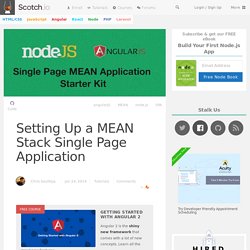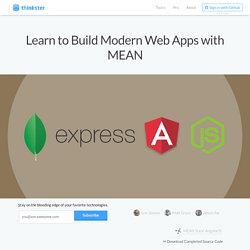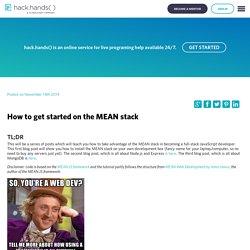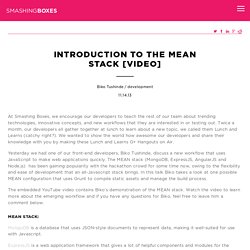

MEAN Stack – Need of Modern Businesses. MEAN Web Development – Coding Tutorial & Additional Information. Explore MEAN Stack at 2015. MEAN Stack RESTful API Tutorial (1/5) - Using MongoDB, Express, Angular JS, and Node JS Together. MEAN Stack Example. Setting Up a MEAN Stack Single Page Application. Free Course Getting Started with Angular 2 Angular 2 is the shiny new framework that comes with a lot of new concepts.

Learn all the great new features. Beginning an application from scratch can sometimes be the hardest thing to do. Staring at an empty folder and a file with no code in it yet can be a very daunting thing. In today’s tutorial, we will be looking at the starting setup for a Node.js, AngularJS, MongoDB, and Express application (otherwise known as MEAN). This will be a starting point for those that want to learn how to begin a MEAN stack application.
You will be able to start from absolute scratch and create a basic application structure that will allow you to build any sort of application you want. This article has been updated to work with Express 4.0 # What We’ll Be Building A lot of the applications we’ve dealt with so far had a specific function, like our Node and Angular To-Do Single Page Application. Application Requirements # The Backend Node, MongoDB, Express That’s it! <! Learn to Build Modern Web Apps with MEAN. The goal of this tutorial is to guide you through the creation of a Reddit/Hacker News clone using the MEAN stack.

By completing this tutorial, you will gain a basic understanding of the MEAN stack including building a REST interface with Express.js on top of Node.js and using that interface to perform CRUD operations on a database via an AngularJS frontend. Why MEAN Stack? The acronym "MEAN" stands for "MongoDBExpress.js AngularJSNode.js" and represents a group of technologies which are known to synergize well together. The major benefit of the MEAN stack is that it's extremely quick to prototype with.
Node.js allows you to use Javascript on the backend as well as the frontend which can save you from having to learn a separate language. Prerequisites This course assumes knowledge of programming and at least basic knowledge of JavaScript. Use checkboxes to save your progress Install Node.js Install MongoDB Recommendations for Completing this Tutorial Project Specifications Getting Started if(! How to get started on the MEAN stack - HackHands. This will be a series of posts which will teach you how to take advantage of the MEAN stack in becoming a full-stack JavaScript developer.

This first blog post will show you how to install the MEAN stack on your own development box (fancy name for your laptop/computer, so no need to buy any servers just yet). The second blog post, which is all about Node.js and Express is here. The third blog post, which is all about MongoDB is here. Disclaimer: code is based on the MEAN.JS framework and the tutorial partly follows the structure from MEAN Web Development by Amos Haviv , the author of the MEAN.JS framework. Linux server on which you're running anApache web server withMySql as a database andPHP as the backend language. Smashing Boxes. At Smashing Boxes, we encourage our developers to teach the rest of our team about trending technologies, innovative concepts, and new workflows that they are interested in or testing out.

Twice a month, our developers all gather together at lunch to learn about a new topic, we called them Lunch and Learns (catchy right?). We wanted to show the world how awesome our developers and share their knowledge with you by making these Lunch and Learns G+ Hangouts on Air. Yesterday we had one of our front-end developers, Biko Tushinde, discuss a new workflow that uses JavaScript to make web applications quickly. The MEAN stack (MongoDB, ExpressJS, AngularJS and Node.js) has been gaining popularity with the hackathon crowd for some time now, owing to the flexibility and ease of development that an all-Javascript stack brings. In this talk Biko takes a look at one possible MEAN configuration that uses Grunt to compile static assets and manage the build process. MongoDB, Express, AngularJS, Node.js. Enterprise web applications are built on a three-tier architecture, which consists of three important layers: data, logic, and presentation.

In web apps, the application structure generally comprises of database, server, and client. While in modern web development, it comprises of database, server logic, client logic, and client UI, which is known as the MVC (Model View Controller) architectural pattern. In the MVC paradigm, the logic, data, and visualization are separated into three types of objects, each handling its own tasks. The “View” handles the visual part, taking care of user interaction. The “Controller” responds to system and user events, commanding the Model and View to change appropriately. In the 25 years of web development, many technology stacks became popular.